Mi SciELO
Servicios Personalizados
Revista
Articulo
Indicadores
-
 Citado por SciELO
Citado por SciELO
Links relacionados
-
 Similares en
SciELO
Similares en
SciELO
Compartir
Mendive. Revista de Educación
versión On-line ISSN 1815-7696
Rev. Mendive vol.22 no.1 Pinar del Río ene.-mar. 2024 Epub 10-Mar-2024
Original article
Educational management for teaching performance at the Educational Institution 16228 San Luis
1Universidad Católica de Trujillo, Perú
2Universidad Cesar Vallejo, Perú
The management of processes in an organization constitutes a key element for its operation and constant improvement, which when speaking of an educational institution is enhanced, depending on the approach that is given to it as a process, taking into consideration that educational management not only addresses the processes themselves and their operation, but also takes into account the performance of the subjects who participate in it, in this article, it is addressed from the pedagogical context of the educational institution 16228 San Luis San Luis de Bagua Grande in Peru, educational management for teacher performance, from the analysis of the corresponding variables and dimensions. For this, we worked with a sample of 46 teachers from said institution. The main results were demonstrating the existing correlation between educational management and how it impacts teacher performance, with a greater incidence in curricular planning and leaving gaps even in school coexistence, learning monitoring and curricular execution.
Keywords: management; teaching performance; processes
Introduction
The educational management model to improve the performance of teachers in underdeveloped and third world countries has always been questioned; unlike developed countries, which lead the world's scores in international assessments, which are clearer about what they pursue in their educational models. Therefore, the latter inspire the development of their countries through the implementation of quality education and, therefore, their professionals are the best paid in the system and receive the relevant incentives to contribute to the growth of the country.
In this regard, Paz (2020) maintains that educational management has significantly influenced the performance of teachers in all latitudes of the world; However, despite the efforts made, these are questioned. For many decades and centuries, educational policies have been postponed by their authorities, demonstrating poor educational management; other sectors have been prioritized and in most cases those that are related to their personal interests.
This situation was revealed with greater force in the period marked by the presence of the COVID-19 pandemic, which showed deficiencies in the management of education, confirming a culture of deficiencies in educational management, affecting the performance of teachers. which has its clearest expression in the use of technological tools to execute the strategy of remote and distance education.
In relation to this, Vega (2020) states that teaching performance has always been related to the educational management model that is implemented in the countries. In this regard, international efforts have been implemented since the 1950s; institutions have been created under the management of the Ministry of Education, in order to evaluate the academic performance of students, maintaining the constant that good management Education contributes to teacher performance and the performance of students largely depends on this. Among them we have: the Laboratory for Evaluation of the Quality of Education (LLECE), managing to have a significant impact throughout Latin America by discovering that all the countries in the region had as a result of their learning an average below that of industrialized countries; and this depends on the educational management model that is being implemented.
The study carried out by Armas and Bardales (2020) reveals that the rulers of a large part of the Latin American countries responsibly opted for an educational management model that responds to the demands, according to the results achieved, demonstrating greater responsibility in Chile and Mexico, Then the other countries gradually joined in. Mexico led the way, and in 1993 they designed an educational management system with salary improvements for teachers, through voluntary evaluation of teachers within the framework of the Teaching Career Program, from the perspective of merit payment based on two fundamental axes: school achievement, which consisted of making students get the best results on a scale of 8; and the professionalism of the teacher, academic degrees, specialties, merits achieved and seniority, among others.
Chile, for its part, took another route and did so from the implementation of an Educational Management Model in the National Performance Evaluation System of Subsidized Educational Establishments. That is why teachers who achieve the best results are eligible for financial improvements called a subsidy for excellent performance. Both experiences, recognized by the Inter-American Development Bank (IDB), are complex methodologies and depend on an educational management model to evaluate teaching performance, since the results achieved by students not only depend on the teaching factor; There are others of greater incidence such as the socioeconomic conditions of the parents, the motivational stimuli of the place of birth, among others.
Currently, educational management, according to what was said by Gálvez and Milla (2018), indicates that implementing a new educational management model in Peru, through educational reform, prioritizes education in educational policies and values the participation of educational agents as protagonists of change. It is in this context that the teacher's performance is valued, which through the implementation of a new educational management model will make it gain strength and be considered more seriously to make educational policies an essential element to achieve educational changes.
In the Amazonas region, according to statements from the Ministry of Education (Huapaya, 2020), the entities of the Ministry of Education (MINEDU) are not implementing a serious educational management proposal for teacher performance, but rather are focusing on strict compliance with the regulations emanating from it. They do the above for the sole purpose of checking the development of professional skills and performance in the Framework of Good Teaching Performance (MBDD), identifying their training needs during the service to provide the respective support, in order to improve performance. of their teaching practice and ensuring that all appointed teachers participate in the evaluations called by the MINEDU.
Unfortunately, Amazonas has the Condorcanqui province, which requires educational management with greater vision in the education sector by its political and educational authorities. The entire province speaks the Awajun language and every year it has the lowest results at the national level, because the tests are taken in Spanish. Furthermore, the performance of the teachers is minimal and, in some cases, almost zero, when these schools are designated or appointed Spanish-speaking teachers who are completely unaware of the language and, most of their time is spent learning the language and, when They are served by their own Awajun-speaking residents, they are unaware of the methodological strategies to build solid learning, which makes them become a priority for bilingual intercultural education.
At the local level, educational institution No. 16228 San Luis-Bagua Grande does not have an educational management model. Managers are not concerned with improving the performance of their teachers, but are more concerned with growing in the quantity of attention to students and not in quality; That is why teachers are poorly supervised in their performance. With respect to the teaching profession, there is a mixed feeling among the majority of teachers: new teachers hired and appointed do not have difficulty joining the new teaching career, on the contrary, they are the ones who voluntarily assume responsibilities that lead to a better teaching performance; while the old teachers, who are the majority, resist and are organized on a SUTEP basis, and constantly try to persuade other teachers to comply with measures against the new teaching career. This often causes meetings to become tense moments. In this regard, the present study is of utmost importance and its objective is focused on specifying the existing relationship between educational management and teaching performance in our institution, because it will allow, through its analysis, to enhance elements of educational management in order to improve the teaching performance and, as an end, the development of student training.
Materials and methods
The research is non-experimental, with a descriptive design, as it focused on carrying out characterizations of a phenomenon, or fact, with the purpose of defining its organization or behavior. It is located at the intermediate level in the characterization of teaching performance, seeking to understand the reasons for the performance of teachers in their work and of students in their academic results.
The population was made up of 46 teachers from the primary and secondary levels of educational institution No. 16228 of the San Luis hamlet in the city of Bagua Grande.
Likewise, the techniques and instruments described below were used:
Office techniques: allowed the collection of information from its application in a meeting with directors, where the teaching performance of the institution's teachers was addressed.
Summary sheets: with the purpose of collecting all the main data of the study topic. It contains the main ideas of the topic and also the references.
Textual tokens: to collect a portion or fragment of a written document without making modifications. It was used essentially in the sections referring to the theoretical and conceptual framework.
As an experimental, hypothesis testing method, it allowed obtaining specific data to answer specific questions through the evaluation instrument, questionnaire and interview.
The variables were taken into account in the study:
Independent variable: educational management model.
Dependent variable: teaching performance.
In the Educational Management Model variable, the dimensions were determined: administrative management, pedagogical management, institutional management, community management.
In the Teaching Performance variable, the dimensions were determined: curricular planning, curricular execution, school coexistence, learning monitoring.
Results
Figure 1 shows that, of the 46 teachers surveyed on the subject of administrative management, 21.8% are at the very poor level, 17.4% are at the poor level, 47.8% are at the good level and only 13% are at the efficient level. From the results achieved, it is inferred that there is an urgent need to implement an educational management model that allows the improvement of teaching performance in the educational institution N°16228 San Luis de Bagua Grande.
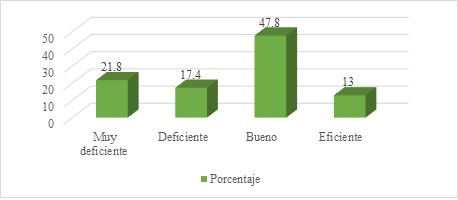
Fig. 1 - Level of the Administrative Management dimension of the Educational Management Model variable in the educational institution N°16228 San Luis de Bagua Grande-2021
Figure 2 shows that of the 46 teachers surveyed on the subject of pedagogical management curricular execution, 21.7% are at the very poor level, 17.4% are at the poor level, 34.7% are at the good level and only the 26.2% is at the efficient level. From the results achieved, it is inferred that there is an urgent need to apply an educational management model that enhances the continuous improvement of teaching performance in educational institution N°16228 San Luis de Bagua Grande.
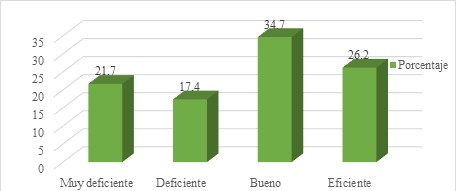
Fig. 2 - Level of the Pedagogical Management dimension of the Educational Management Model variable in the educational institution N°16228 San Luis de Bagua Grande-2021
In Figure 3, it can be seen that of the 46 teachers surveyed on the institutional management dimension, 21.7% are at the very poor level, 30.4% are at the poor level, 32.6% are at the good level and only 15.2% are at the good level. % falls within the efficient level. From the results achieved, it can be inferred that it is necessary to implement in practice an educational management model that enhances the indicators of institutional management in educational institution N°16228 San Luis de Bagua Grande.
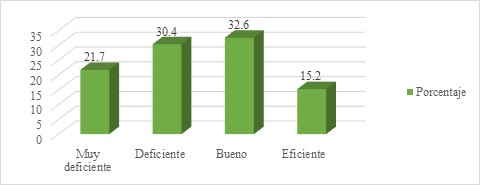
Fig. 3 - Level of the institutional management dimension of the Educational Management Model variable in educational institution N°16228 San Luis de Bagua Grande-2021
Figure 4 shows that, of all 46 teachers surveyed about community management, 26.1% are in the very poor level range, 21.7% are in the poor level, 39.1% are in the good level and 13.1% is part of the efficient level. From the results it can be concluded that it is necessary to apply an educational management model that enhances the improvement of teaching performance in the educational institution N°16228 San Luis de Bagua Grande.
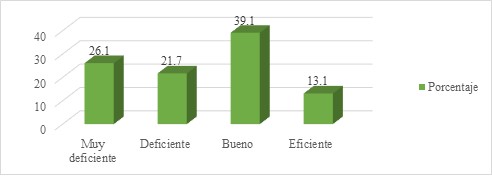
Fig. 4 - Level of the Community Management dimension of the Educational Management Model variable in educational institution N°16228 San Luis de Bagua Grande-2021
Comparison between the dimensions of the Educational Management Model variable
Figure 5 shows that in the educational institution No. 16228 San Luis de Bagua Grande, to use an educational management model and improve the performance of teachers, it is necessary to point out Administrative Management, which reaches 47.8% good and in Community Management with a 39.1% good level, followed by the Pedagogical Management dimension that reaches a 34.7% good level and finally the Institutional Management dimension with a 32.6% good level.
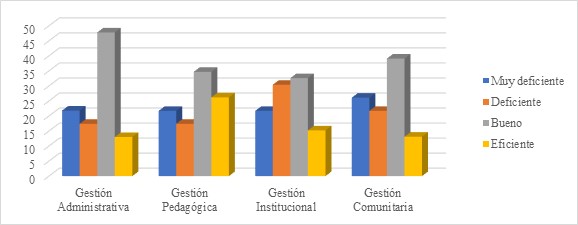
Fig. 5 - Level of the dimensions of the Educational Management Model in educational institution N°16228 San Luis de Bagua Grande-2021
Figure 6 shows that of the total of 46 teachers surveyed about curricular planning, 43.5% are at the very poor level, 21.7% are at the poor level, 26.1% belong to the good level and only 8.7% are at the good level. % is at the efficient level; From the results achieved, it is inferred that there is an urgent need to apply an educational management model that facilitates the improvement of teaching performance in educational institution N°16228 San Luis de Bagua Grande.
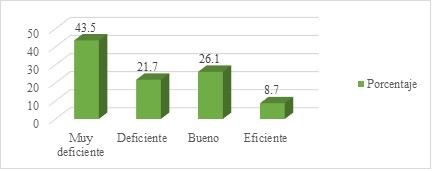
Fig. 6 - Level of the curricular planning dimension to improve teaching performance in the educational institution N°16228 San Luis de Bagua Grande-2021
Figure 7 shows that, of all (46) of the teachers surveyed about curricular execution, 39.1% are at the very deficient level, 32.6% are part of the deficient level, 17.4% are at the good and only 10.9% is at the efficient level. From the results it is possible to infer that there is an urgent need to apply an educational management model that contributes to the improvement of teaching performance in the educational institution N°16228 San Luis de Bagua Grande.
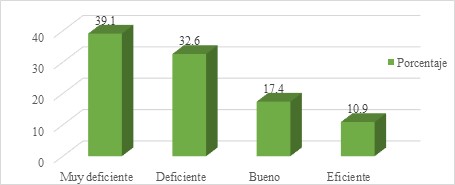
Fig. 7 - Level of the curricular execution dimension to improve teaching performance in educational institution N°16228 San Luis de Bagua Grande-2021
Figure 8 shows that, of the 46 teachers surveyed regarding school coexistence, 30.4% are at the very poor level, 32.6% are at the poor level, and 21.7% are in the good level range, and only 15.2% belongs to the efficient level. From the results achieved, it can be inferred that an urgent application of an educational management model is necessary that enhances the improvement in teaching performance at educational institution N°16228 San Luis de Bagua Grande.
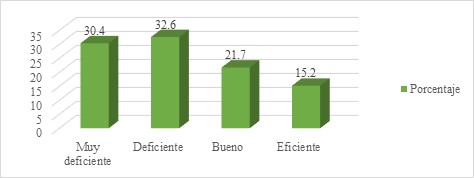
Fig. 8 - Level of the school coexistence dimension to improve teaching performance in educational institution N°16228 San Luis de Bagua Grande-2021
Figure 9 shows that all (46) of the teachers surveyed regarding learning monitoring, 34.8% are at the very deficient level, 21.7% are at the deficient level, 32.6% belong to the good level and only 10.9% is at the efficient level. Therefore, it can be inferred that the application of an educational management model that facilitates the improvement of teaching performance in educational institution N°16228 San Luis de Bagua Grande is necessary and urgent.

Fig. 9 - Level of the learning monitoring dimension to improve teaching performance in educational institution N°16228 San Luis de Bagua Grande-2021
Comparison between the dimensions of teaching performance
Figure 10 shows that in the educational institution No. 16228 San Luis de Bagua Grande, to improve the performance of teachers, the curricular planning must be specified, which reaches: 43.5% very poor and 26.1% good, continuous level of the curricular execution dimension that reaches 39.1% very deficient and 32.6% deficient. Very close is the dimension of school coexistence, which reached 30.4%, very poor level and 32.6%, poor level; Finally, the learning monitoring dimension reached 34.8% very poor level and 32.6% good level.
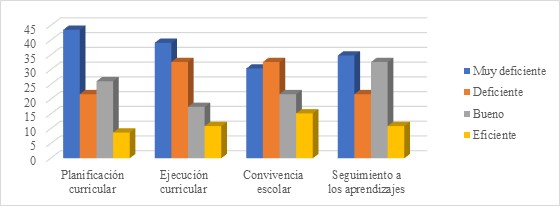
Fig. 10 - Level of the dimensions of teaching performance in educational institution N°16228 San Luis de Bagua Grande-2021
Table 1 shows the distribution of the evaluations in the questionnaires provided from the selected sample, so that, for the educational management questionnaire and its respective dimensions, the distribution behaves as non-normal with p<.05, in a similar way. occurs in the dimensions of teaching performance, there is no presence of normality with p<.05, expressing the need to use non-parametric statistics to validate the hypotheses.
Table 1 - Test of normality of the instruments applied to the teachers of Educational Institution No. 16228 San Luis de Bagua Grande-2021
| Variable/ dimensions | Kolmogorov-Smirnova | ||
|---|---|---|---|
| Statistical | gl | Next. | |
| Education Management | |||
| Administrative management | .252 | 3 | ,000 |
| Pedagogical Management | .175 | 3 | ,000 |
| Institutional management | .243 | 3 | ,000 |
| Community Management | .206 | 3 | ,000 |
| Teaching Performance | |||
| Curriculum planning | .211 | 3 | ,000 |
| Curriculum execution | .355 | 3 | ,000 |
| School life | .292 | 3 | ,000 |
| Monitoring of learning | .236 | 3 | ,000 |
Source: Data processing in SPSS
Discussion
The literature that supports the results achieved, coinciding with the contribution of the study by Hernández et al. (2019), who maintain that the evaluation of teaching performance should be part of the profile of the Colombian teacher; But this must be done from a business perspective within the framework of the discourse of teaching excellence, striking the chord in pedagogical practice and political guidelines, moving away from the position of looking at co-workers with an alternative position. Likewise, Gómez and Valdés (2019) does so at the national level, through the application of the survey instrument to graduates of the Systems Engineering degree at the Pontificia Universidad Católica del Perú; They state that the work space is difficult and demanding, despite the training received to face challenges of work performance, the main strategic ally being self-evaluation, which goes hand in hand with the development of critical-reflective, self-reflecting, self-analyzing and self-evaluating skills. the strategies applied during teaching performance.
In this regard, it is expressed that teachers who know and work with the internal regulations, rules of coexistence, positive discipline and conflict resolution improve their teaching performance; To do this, we take into account Albert Bandura's theory of self-efficacy, regarding which Rosales and Hernández (2020) express that, its purpose being to demonstrate that the behavioral, cognitive, affective and contextual aspects are linked to self-efficacy, through the scientific nature of psychology, the postulates were validated by developing a methodology that contributed to human problems. Likewise, the research developed by Berrios et al. (2020) highlights how the analysis of institutional self-assessment from the processes is strengthened by the positive influence of leadership, thus allowing academic performance to be recognized as a fundamental element in educational management. The theory of school management also does so within the framework of decentralization, according to Castro and Enrico (2019), who affirm that in Latin America there is a tendency to decentralize educational processes through educational reforms in their countries, seeking convergences and contrasts. about the experiences lived in each of their realities, based on empirical evidence. Finally, we have the contribution of the theory of inclusive leadership according to Valdés (2022), stating that the school management model in current times must be focused on the pedagogical leadership of its teachers and directors, because it allows the systematization of experiences typical of the educational institution; That is why it is framed in principles binding on school learning.
Likewise, Galaz et al., (2023) share the Mexican and Chilean experience through comparative research, concluding that teachers are not opposed to being evaluated because in this way the performance of teachers is improved and the quality of education is also raised; but they do not agree with the ways in which they are evaluated, because it is not formative and takes away their autonomy, recognizing benefits in the rigor and application of evaluation instruments. In the same way, at the national level Peña (2020) does so, considering that there is a direct relationship between these variables and that, to the extent that the educational management carried out at the institutional level takes into consideration, the needs of the process. which includes the systematic training of teachers and the integration of Information and Communications Technologies (ICT) in the training process, the results in the teacher's performance will be more visible.
The aforementioned results and their discussion allow us to reject the null hypothesis that promulgates the lack of relationship between the variables, so it can be indicated that the teachers studied demonstrate a fairly good knowledge of administrative management, pedagogical management, institutional management and community management and that this will improve their teaching performance in the dimensions: curricular planning, curricular execution, school coexistence and monitoring of learning; which leads to the integral relationship between the two study variables. The results obtained are directly related to those endorsed by the literature consulted, including Fernández et al. (2016), which from the experience of Riobamba, Ecuador, mentions that the educational quality and performance of teachers must be framed in the educational model that is aspired to as an educational institution; It must be democratic in nature, so that the claims for change are approved by all educational agents. In relation to this, Quispe (2020), from the private educational institution "Bertolt Brecht" in the Cercado district of Lima, shares a positive aspect to improve teaching performance, when referring to the relationship between teacher performance and educational management of managers, reaching a significance of 0.000 level of 0.819 less than 0.05 points.
Referencias bibliográficas
Armas, M. S. & Bardales, J. M. D. (2020). Gestión Educativa en el desarrollo del aprendizaje en las Instituciones Educativas. Ciencia Latina Revista Científica Multidisciplinar, 4(2), 1819-1838. https://doi.org/10.37811/cl_rcm.v4i2.196 [ Links ]
Berrios, A., Aravena, M., García-Carmona, M. & Martín Bris, M. (2020). Liderança e auto-avaliação institucional.Revista Ibero-Americana De Estudos Em Educação,15(esp4), 2600-2610. https://doi.org/10.21723/riaee.v15iesp4.14508 [ Links ]
Castro, A. M. & Enrico, J. (2019). Reflexiones en torno a la administración y la organización educacional en cronoespacios contemporáneos de descentralización, control y autonomía. Revista Latinoamericana de Políticas y Administración de la Educación, (11), 28-39. http://revistas.untref.edu.ar/index.php/relapae/article/view/305 [ Links ]
Fernández-Fernández, I. M., Véliz-Briones, V., & Ruiz-Cedeño, A. I. (2016). Hacia una cultura pedagógica inclusiva: Experiencias desde la práctica universitaria. Revista Electrónica Educare, 20(3), 262-276. http://dx.doi.org/10.15359/ree.20-3.13 [ Links ]
Galaz-Ruiz, A. & Anaya-Torres, E.D. (2023). Repensando la evaluación docente: Chile-México.Estudios pedagógicos (Valdivia),49(1), 203-218.https://dx.doi.org/10.4067/s0718-07052023000100203 [ Links ]
Gálvez Suarez, E. & Milla Toro, R. (2018). Evaluación del desempeño docente: Preparación para el aprendizaje de los estudiantes en el Marco de Buen Desempeño Docente. Propósitos y representaciones, 6(2), 407-429. http://dx.doi.org/10.20511/pyr2018.v6n2.236 [ Links ]
Gómez, L. F. & Valdés, M. G. (2019). La evaluación del desempeño docente en la educación superior. Propósitos y representaciones , 7(2), 479-515. http://dx.doi.org/10.20511/pyr2019.v7n2.255 [ Links ]
Hernández-Maldonado, E. T., Rojas-Guevara, J. U. & Gallo-Vargas, R. D. (2019). La práctica docente y su evaluación: estrategia para la mejora continua en los procesos de acreditación en alta calidad. Revista de Investigación, Desarrollo e Innovación, 10(1), 79-92. https://doi.org/10.19053/20278306.v10.n1.2019.10013 [ Links ]
Huapaya Capcha, Y. A. (2020). Autoevaluación institucional desde el enfoque de la gestión de procesos del Ministerio de Educación (MINEDU) en la gestión de la convivencia escolar en la Institución Educativa Jesús Obrero distrito de Comas2019. Perú: UNMSM, http://cybertesis.unmsm.edu.pe/handle/20.500.12672/14779 [ Links ]
Paz Flores, T. M. (2020). Gestión educativa y la mejora del desempeño laboral de los docentes.Ciencia Y Educación, 1(4), 15-26. https://doi.org/10.48169/Ecuatesis/0104202021 [ Links ]
Peña Prado, R. A. (2020). El aprendizaje organizacional como factor de cambio en la Administración Educativa.Revista De Estilos De Aprendizaje,13(25), 99-112. https://doi.org/10.55777/rea.v13i25.1504 [ Links ]
Quispe-Pareja, M. (2020). La gestión pedagógica en la mejora del desempeño docente.Investigación Valdizana,14(1), 714. https://doi.org/10.33554/riv.14.1.601 [ Links ]
Rosales-Ronquillo, C.A., & Hernández-Jácquez, L.F. (2020). Autoeficacia académica y su relación con el rendimiento académico en estudiantes de nutrición.Revista Electrónica Educare ,24(3), 139-155.https://dx.doi.org/10.15359/ree.24-3.7 [ Links ]
Valdés Morales, R. (2022). Liderazgo escolar inclusivo: una revisión de estudios empíricos.Zona Próxima, (36), 4-27. Epub June 11, 2022. https://doi.org/10.14482/zp.36.3719 [ Links ]
Vega Gutiérrez, L. V. (2020). Gestión educativa y su relación con el desempeño docente.Ciencia Y Educación , 1(2), 18-28. https://doi.org/10.48169/Ecuatesis/0102202008 [ Links ]
Received: May 25, 2023; Accepted: January 30, 2024











 texto en
texto en 



